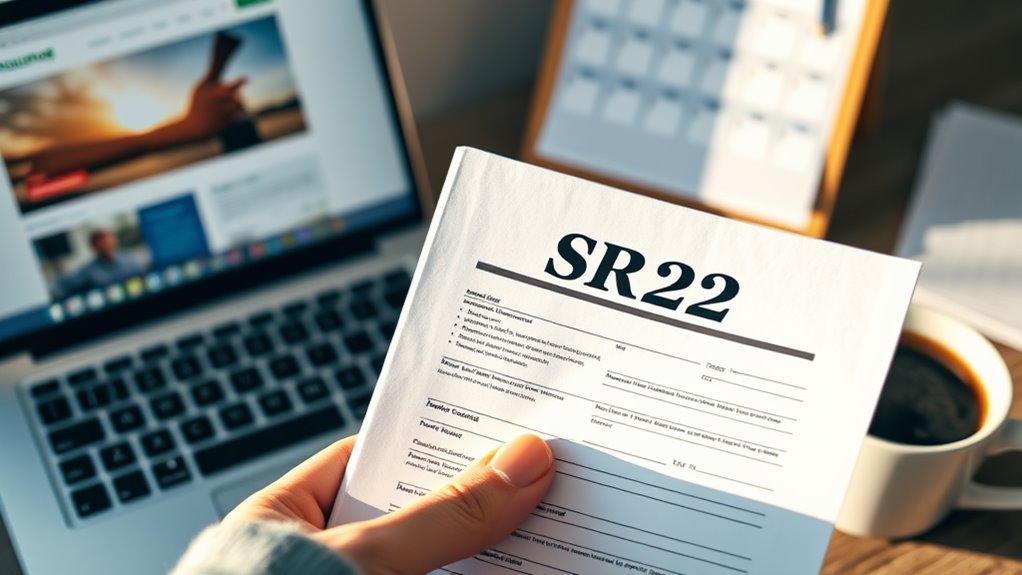Filing for your state's SR-22 insurance doesn't have to be complicated. By knowing your state's specific requirements and gathering the right documentation, you can streamline the process. You'll want to contact insurance providers who handle SR-22 filings and compare your options carefully. Understanding the importance of continuous coverage is vital. Ready to learn the essential steps that will keep you compliant and avoid unnecessary penalties? Let's explore what you need to do next.
Key Takeaways
- Research your state's specific SR-22 requirements, including coverage limits and duration, to ensure compliance and avoid penalties.
- Collect necessary documentation, such as driver's license, vehicle registration, and insurance history, before contacting an SR-22-friendly insurance provider.
- Compare quotes from multiple insurers to find competitive rates and assess coverage options that meet your state's minimum requirements.
- Maintain continuous insurance coverage to prevent lapses, which can lead to severe penalties and potential license suspension.
- Submit the SR-26 form promptly to the DMV upon cancellation of your policy, and keep copies for your records to confirm processing.
Understand Your State's SR-22 Requirements

When traversing SR-22 requirements, have you considered how much they vary by state? Each state has its own minimum coverage requirements, which can greatly impact your insurance. For example, California mandates $15,000 in bodily injury per person, while Texas requires $30,000. Offenses triggering SR-22 filings differ too; DUIs might necessitate it in one state but not in another. The duration of SR-22 requirements also varies, typically lasting from one to five years. Additionally, filing costs are usually low, around $25, but high-risk status can inflate your insurance premiums. It is crucial to maintain continuous coverage during the specified period to avoid penalties. Furthermore, understanding your state's SR-22 insurance laws can help you make informed decisions regarding your policy.
It's essential to understand these differences, as your state's rules will dictate your coverage needs and financial obligations. Stay informed to navigate your SR-22 filing effectively.
Gather Necessary Documentation
Maneuvering SR-22 requirements means gathering the right documentation to guarantee a smooth filing process.
Start with a valid copy of your driver's license and proof of vehicle registration in your name. You'll also need employment verification for the past three months and documentation of your insurance history.
Gather a valid driver's license, vehicle registration, employment verification, and insurance history for your SR-22 filing.
Don't forget to collect any traffic tickets or court documents related to violations, especially if there's a DUI or DWI involved. Obtain your SR-22 forms from a licensed insurer, along with proof that your insurance meets state minimum coverage.
Be prepared for filing fees, which usually hover around $25. Finally, check your state's specific requirements, as they can vary greatly. Staying organized will help streamline your filing experience.
Contact Your Insurance Provider
Before diving into the SR-22 process, it's essential to contact your insurance provider to confirm they offer SR-22 forms. Not all companies handle this, so you'll need to verify yours does.
Ask about the filing process; typically, they manage it with the state's DMV. Make certain your provider is licensed in your state and meets specific SR-22 requirements.
It's also wise to inquire about any fees associated with filing, which usually range from $25 to $50. Don't hesitate to seek support from customer service representatives who can assist you through the process.
Compare Insurance Quotes

Comparing insurance quotes is vital for finding the best SR-22 coverage that fits your needs and budget. Gather quotes from multiple SR-22-friendly providers to identify competitive rates.
Remember, costs vary based on factors like your driving history, vehicle type, and location, so it's important to assess these elements before finalizing your choice. Evaluate coverage levels to make certain they meet state requirements, and don't overlook potential discounts, such as multi-policy savings.
Assess your deductible to balance monthly premiums with out-of-pocket costs. Some insurers, like Progressive and State Farm, offer favorable rates, so negotiate if possible.
Taking the time to compare quotes can lead to significant savings and better coverage tailored to your situation.
Consider Non-Owner SR-22 Policies
If you don't own a car but need to meet state insurance requirements, a non-owner SR-22 policy could be the perfect solution.
These policies provide liability coverage when you drive vehicles you don't own, making them ideal for those who frequently borrow or rent cars. Non-owner SR-22s are especially beneficial for high-risk drivers, such as those with DUI convictions, allowing you to comply with state mandates without owning a vehicle.
To obtain one, shop around for insurers that offer non-owner policies, and inform them about your SR-22 need.
Be Aware of Filing Fees
When it comes to SR-22 insurance, it's essential to be aware of filing fees that can add to your overall costs. Most states charge a one-time fee for SR-22s, typically around $25, but this can vary by state and insurance company.
Some insurers may include the SR-22 filing fee in their quotes, while others bill it separately. If multiple drivers on your policy need SR-22s, fees apply per driver.
Since not all insurers offer SR-22 insurance, you might need to shop around. Understanding these fees upfront can help you budget effectively and avoid surprises.
Always clarify with your provider about any potential costs associated with obtaining your SR-22.
Maintain Continuous Coverage

Keeping your SR-22 insurance active and uninterrupted is essential for maintaining your driving privileges. Any lapse in coverage can lead to severe penalties, including license suspension.
If your coverage lapses, your insurance provider must notify the state, potentially restarting your SR-22 duration and incurring additional fines. Continuous coverage also helps keep your insurance rates stable; interruptions can negatively impact your premiums.
States closely monitor SR-22 policies, and any lapse triggers automatic notification. To prevent penalties, consider setting up automatic payments, communicating regularly with your insurer about your financial situation, and budgeting specifically for your SR-22 insurance.
Know the Duration of SR-22 Terms
Understanding the duration of SR-22 terms is essential for anyone maneuvering the complexities of driving after a serious offense. Typically, SR-22 requirements last for three years, but this can vary by state and the nature of your offense.
Understanding SR-22 terms is crucial for navigating driving post-offense, as durations typically vary by state and offense type.
For instance, a DUI conviction often mandates a three-year SR-22 in many states, while Texas may require it for two to three years after certain violations.
Keep in mind that court decisions and state DMV rules can influence these durations. Failing to maintain your SR-22 coverage can extend the term, leading to additional penalties, including license suspension.
Being proactive about your insurance compliance will help you navigate these requirements effectively and avoid unnecessary complications.
Monitor Your Insurance Status
To successfully navigate the requirements of SR-22 insurance, it's vital to actively monitor your insurance status. Regularly review your policy documents for updates and confirm your SR-22 filing through your insurer's online portal.
Keep detailed records of all communications with your insurance provider and verify they're notifying the state about your coverage. Timely premium payments are important; set reminders or automate payments to avoid lapses that could lead to cancellations.
Utilize technology, such as mobile apps, to track your policy and receive alerts about renewals. Finally, stay informed about any state-specific changes in SR-22 requirements by checking official resources to make sure you remain compliant and avoid complications.
Request Removal After Compliance
Once you've met the necessary compliance requirements, requesting the removal of your SR-22 can be a straightforward process.
First, confirm with your DMV the exact end date of your SR-22 mandate; this typically lasts three years but can vary.
Contact your insurance provider to initiate the removal; they'll submit the SR-26 form to the DMV.
Be cautious about canceling early, as it could lead to penalties or license suspension.
After the SR-22 is removed, you may notice a decrease in your insurance rates, so consider shopping around for better coverage options.
Finally, make sure you maintain continuous insurance coverage to avoid any legal complications moving forward.
Conclusion
In summary, maneuvering through the SR-22 process doesn't have to be a headache. By understanding your state's requirements and staying organized, you can keep everything running smoothly. Remember, it's essential to maintain continuous coverage and monitor your status. Once you've fulfilled the necessary terms, don't hesitate to request the removal of your SR-22. Stay proactive, and you'll be back on the road without a hitch in no time!

